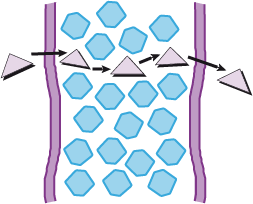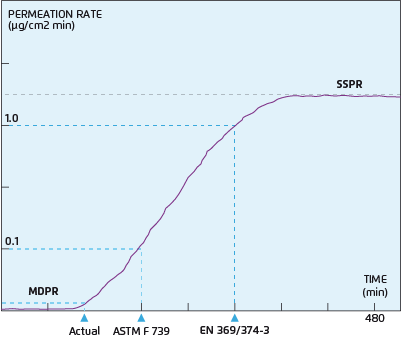Weerstand tegen indringing door chemicaliën EN6529:2001
WAT IS INDRINGING?

Indringing is het proces waarbij een gevaarlijke vloeibare chemische stof op moleculair niveau door een beschermend materiaal heen dringt. Indringing kan worden weergegeven door het volgende vereenvoudigde schema.
- Sorptie van moleculen van een vloeistof op het contact makende oppervlak (buitenzijde) van het materiaal.
- Verspreiding van de gesorbeerde moleculen over het materiaal.
- Desorptie van de moleculen vanaf het tegenovergestelde oppervlak (binnenzijde) van het materiaal.
METEN VAN DE INDRINGING
De barrière-eigenschappen van een beschermend materiaal of een beschermende naad tegen indringing door een potentieel gevaarlijke chemische stof, worden bepaald door het meten van de doorbraaktijd van de chemische stof door een testmateriaal. Indringingstests worden uitgevoerd volgens de ASTM F739, EN 369 of EN 374-3 testmethoden afhankelijk van het land van gebruik en de lokale voorschriften en de fysieke toestand van het gevaarlijke materiaal.
Het buitenoppervlak van een testmateriaal wordt blootgesteld aan een vloeibare chemische stof of gas met gebruikmaking van een indringingstestcel. Doorbraak van de chemische stof naar de binnenzijde van het materiaal wordt gecontroleerd door het bemonsteren van de verzamelzijde van de cel en het analytisch bepalen wanneer de chemische stof door het materiaal is gedrongen door middel van een massaspectrometer.
Permeation Rate (indringingssnelheid) - PR
De snelheid waarmee de gevaarlijke chemische stof door het testmateriaal dringt. De indringingssnelheid wordt uitgedrukt als een bepaalde massa gevaarlijke chemische stof die door een oppervlak van het materiaal heen dringt per eenheid tijd, bv. 2,0 µg/cm2 / min. ofwel 2 miljoenste van een gram per vierkant centimeter per minuut.
Steady State Permeation Rate (Stationaire indringingssnelheid) - SSPR
De constante indringingssnelheid die zich voordoet na een doorbraak wanneer het contact met de chemische stof constant is en alle krachten die uitwerken op de indringing een evenwicht hebben bereikt.
Minimum Detectable Permeation Rate (Minimale detecteerbare indringingssnelheid) – MDPR
De minimale indringingsnelheid die kan worden gedetecteerd tijdens een indringingstest. MDPR is een functie van de gevoeligheid van de analytische meettechniek, het volume van de verzamelde chemische stof en de bemonsteringstijd. Minimum detecteerbare indringingssnelheden kunnen in bepaalde gevallen zo laag zijn als 0,001 μg/cm2 per minuut.
WERKELIJKE BREAKTHROUGH DETECTION TIME (DOORBRAAK DETECTIETIJD) – BDT
De gemiddelde tijd die verstrijkt tussen het eerste contact van de chemische stof en het buitenoppervlak van het materiaal en de detectie van de chemische stof aan het binnenoppervlak door het analyse-apparaat.
Een werkelijke doorbraaktijd van >480 minuten en een indringingssnelheid van “nd”(niet gedetecteerd) betekent niet dat er geen doorbraak is. Het betekent dat de indringing niet gedetecteerd is na een observatietijd van acht uur.
Indringing kan hebben plaatsgevonden, maar met een snelheid die minder is dan de detecteerbare indringingssnelheid (MDPR) van het analyse-apparaat. De MDPR kan variëren afhankelijk van de chemische stof of het analyse-apparaat.
Bij het selecteren van een chemisch barrièremateriaal worden de MDPR en de verwachte blootstellingstijd gebruikt om te bepalen of het beschermingsniveau voldoende is gezien de toxiciteit van de gebruikte chemische stof.
GENORMALISEERDE DOORBRAAKTIJD – VOLGENS ASTM F739
De gemiddelde verstreken tijd tussen het eerste contact met de chemische stof aan het buitenoppervlak van het materiaal en de tijd waarop de chemische stof gedetecteerd wordt aan het binnenoppervlak bij een indringingssnelheid van 0,1 μg/cm2 /min.
GENORMALISEERDE DOORBRAAKTIJD – VOLGENS EN 374-3
De gemiddelde verstreken tijd tussen het eerste contact met de chemische stof aan het buitenoppervlak van het materiaal en de tijd waarop de chemische stof gedetecteerd wordt aan het binnenoppervlak bij een indringingssnelheid van 1,0 μg/cm2/min. Op die manier wordt de doorbraaktijd 'genormaliseerd’ omdat deze onafhankelijk is van de gevoeligheid van het analyse-apparaat. Hierbij wordt de laagste doorbraaktijd geregistreerd.
Een genormaliseerde doorbraaktijd van >480 minuten betekent dat de gemiddelde indringingstijd nooit de vastgestelde snelheid van 1,0 μg/cm2 /min heeft bereikt. Maar het kan zijn dat de chemische stof wel is doorgebroken met een lagere snelheid.

PRESTATIECLASSIFICATIE VAN GENORMALISEERDE DOORBRAAKTIJDEN
Volgens de Europese normering voor Chemische Beschermende Kleding moet de weerstand van kledingmateriaal tegen indringing door chemicaliën gemeten worden volgens EN 369 of EN 374-3. De genormaliseerde doorbraaktijden worden geclassificeerd in zes prestatieklassen. Voor de Europese norm, wordt de correlatietabel tussen de genormaliseerde doorbraaktijd in minuten en de prestatieklasse weergegeven in de volgende tabel:
| Doorbraaktijd (EN 369) in minuten | EN klasse |
|---|---|
| >= 10 | Klasse 1 |
| >= 30 | Klasse 2 |
| >= 60 | Klasse 3 |
| >= 120 | Klasse 4 |
| >= 240 | Klasse 5 |
| >= 480 | Klasse 6 |
WHAT IS PERMEATION?

Permeation is the process by which a hazardous liquid chemical moves through a protective clothing fabric, at a molecular level. Permeation can be represented by the following simplified diagram.
- Sorption of molecules of liquid onto the contacted (outside) surface of the fabric.
- Diffusion of the sorbed molecules across the fabric.
- Desorption of the molecules from the opposite (inside) surface of the fabric.
MEASURING PERMEATION
The barrier properties of a protective fabric or protective seam to permeation by a potentially hazardous chemical, is determined by measuring the breakthrough time and the permeation rate of the chemical through the test material. Permeation tests are conducted following the ASTM F739, EN 369 or EN 374-3 test methods depending on the country of use and their local regulations and the physical state of the hazardous material.
The outside surface of a test fabric is exposed to a liquid chemical or gas using a permeation test cell. Breakthrough of the chemical to the inside fabric surface is monitored by sampling the collection side of the cell and analytically determining when the chemical has permeated across the fabric by use Mass Spectrometer techniques.
Permeation rate (PR)
The rate at which the hazardous chemical permeates through the test fabric. Permeation rate is expressed as a mass of hazardous chemical flowing through a fabric area per unit of time e.g 2.0 µg/cm2 / min. or 2 millionths of a g per square centimetre per minute
Steady state permeation rate (SSPR)
The constant permeation rate that occurs after breakthrough when the chemical contact is continuous and all forces affecting permeation have reached equilibrium
Minimum detectable permeation rate (MDPR)
The minimum permeation rate that can be detected during a permeation test .MDPR is a function of the sensitivity of the analytical measurement technique, the volume into which the permeated chemical is collected and the sampling time. Minimum detectable permeation rates can be as low as 0.001 μg/cm2 per minute in certain cases.
ACTUAL BREAKTHROUGH TIME OR BREAKTHROUGH DETECTION TIME (BDT)
The average time elapsed between initial contact of the chemical with the outside surface of the fabric and the detection of the chemical at the inside surface by the analytical device.
An actual breakthrough time of >480 minutes and a permeation rate of “nd” (not detected) does not mean breakthrough has not occurred. It means that permeation was not detected after an observation time of eight hours.
Permeation may have occurred, but at a rate less than the minimum detectable permeation rate (MDPR) of the analytical device. MDPR can vary depending on the chemical or on the analytical device.
When selecting a chemical barrier fabric, the MDPR and expected exposure times are used to determine if the level of protection is sufficient taking into account the toxicity of the chemical used.
NORMALIZED BREAKTHROUGH TIME –ACCORDING TO ASTM F739
The average elapsed time between initial contact of the chemical with the outside surface of the fabric and the time at which the chemical is detected at the inside surface of the fabric at a permeation rate of 0.1 μg/cm2 / min.
NORMALIZED BREAKTHROUGH TIME – ACCORDING TO EN 374-3
The average elapsed time between initial contact of the chemical with the outside surface of the fabric and the time at which the chemical is detected at the inside surface of the fabric at a permeation rate of 1.0 μg/cm2 / min. Thus the breakthrough time is ‘normalized’ as it is independent of the analyser sensitivity. Here the lowest BT is recorded.
A normalized breakthrough time of >480 minutes means that the average permeation rate never reached the defined rate of 1.0 μg/cm2 /min. However the chemical may have actually broken through but at a lower rate.

PERFORMANCE CLASSIFICATION OF NORMALIZED BREAKTHROUGH TIMES
According to the European standards for Chemical Protective Clothing, the resistance of clothing materials to permeation by chemicals must be measured according to EN 369 or EN 374-3. The normalized breakthrough times are classified into six performance classes. For the European standard, the correlation table between the normalized breakthrough time in minutes and the performance class is shown in the followingtable
| Breakthrough time (EN 369) in minutes | EN Class |
|---|---|
| >= 10 | Class 1 |
| >= 30 | Class 2 |
| >= 60 | Class 3 |
| >= 120 | Class 4 |
| >= 240 | Class 5 |
| >= 480 | Class 6 |

